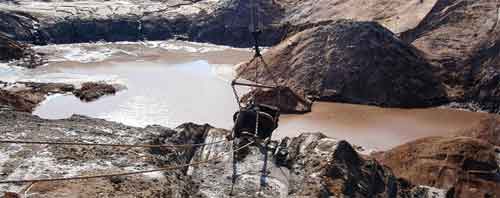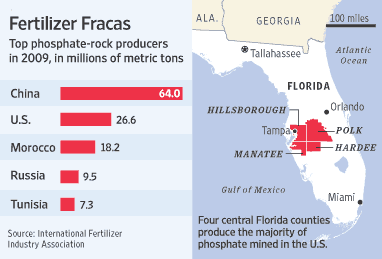redo Jump to...
print Print...
(by Mike Esterl, The Wall Street Journal, WSJ.com) WAUCHULA, Fla. – The phosphate mined for more than a century here in central Florida to make fertilizer has yielded thousands of jobs and countless harvests around the world.
But environmental groups are arguing in federal court that the [abundance of phosphate] extracts too high a price in lost wetlands, spoiled water supplies and ruined farmland.
The Sierra Club and local environmentalists have slammed the brakes on an 11,000-acre mine extension planned by industry giant Mosaic Co. after securing a court injunction in July-the first such ruling in a state that supplies approximately 70% of U.S. phosphate rock for fertilizer. Mosaic is appealing the ruling.
At the same time, the U.S. Army Corps of Engineers plans to begin an environmental review early next year to determine the cumulative impact of phosphate mining in this region-the first such study in Florida since 1978.
The hurdles are threatening jobs in a local economy that is struggling to emerge from recession. Phosphate mining directly employs about 4,000 people in four Florida counties, generating an estimated 20% of the world’s phosphate fertilizer. (see photo below of Four Corners Mine, FL)

In Hardee County, where Mosaic’s mine extension is located, the unemployment rate has more than doubled to 15% since 2007. On the main street of Wauchula, the county seat, about half the store fronts are vacant. “I would hate to see anything happen that prohibits mining,” said Terry Atchley, chairman of the county’s board of commissioners.
Phosphate companies own nearly a quarter of the land in Hardee County, or about 120,000 acres.
Phosphate is extracted from “Bone Valley,” an ancient fossil bed where the nutrient-rich mineral lies. Seven-million-pound “draglines” create vast open-pit mines by digging often 50 feet or deeper with 300-foot-long booms and shovels large enough to cradle trucks. The mix of rock, clay and sand extracted is then separated, before the phosphate is combined with sulfuric acid to produce fertilizer.
Environmentalists say such mines damage wetlands and harm the area’s dwindling water supply. In addition to using water to process phosphate, large areas of clay left behind are less permeable and can block underground water flows. Past spills from such areas have polluted rivers, killing fish.
Critics say the strip mining also renders large tracts of land unusable for agriculture for many years. They also warn of health risks from increased radiation levels, because the mining brings radioactive materials closer to the surface. …
Mosaic says it’s responsible for less than 10% of the region’s groundwater usage and that it carefully rehabilitates mined lands. It also says the proposed South Fort Meade extension in Hardee County has been reviewed by 14 local, state and federal agencies since 2003, producing more than 100,000 pages of documents.
 “We are a highly regulated industry,” said Richard Mack, general counsel of Plymouth, Minn.-based Mosaic, the world’s largest producer of phosphate fertilizer.
“We are a highly regulated industry,” said Richard Mack, general counsel of Plymouth, Minn.-based Mosaic, the world’s largest producer of phosphate fertilizer.
Mosaic, majority-owned by Cargill Inc., estimates its reserves are sufficient to continue mining for another 40 years in Florida. But it only has enough permits to cover about 10 years. The contested South Fort Meade extension would roughly double its permitted reserves.
After a Jacksonville court halted the South Fort Meade extension, Mosaic published advertisements in local newspapers warning it would have to lay off more than 200 workers. That struck a nerve in Hardee County, where mining jobs are among the highest paid and per-capita personal income is barely half the national average. Mosaic has nearly 300 workers in the county, making it the third-largest private-sector employer after a medical rehabilitation center and Wal-Mart Stores Inc. CF Industries Inc., a smaller phosphate miner, ranks fourth. …
Conservation groups have fought back, publishing their own advertisements in local papers and arguing that more jobs would be generated if the land was used for agriculture.
Since 1975, Florida has required phosphate companies to reclaim each acre of land that it mines for other purposes and replace wetlands. By the end of 2008, 69% of the 184,681 acres mined since 1975 had been reclaimed, according to the Florida Department of Environmental Protection.
Mosaic says about 95% of the 30,000 acres it has reclaimed in the past decade have been converted to pasture land for more than 4,500 head of cattle.
Earlier this month, it also unveiled plans to build a 140-room luxury resort-with two 18-hole golf courses designed by Ben Crenshaw-on 16,000 acres of formerly mined land. The Polk County resort is scheduled to open in 2013.
The Environmental Protection Agency says the three-decade-old environmental-impact statement on phosphate mining in central Florida is outdated and that a comprehensive review will allow for better decision-making. The new study will take 18 months to complete, according to the Corps. …..
In late October, environmentalists reached a temporary truce with Mosaic, allowing it to mine an initial 200 acres at the contested site in return for avoiding some wetlands. The new acreage amounts to about four months of mining, postponing the immediate threat of big layoffs. …..
Write to Mike Esterl at mike.esterl@wsj.com.
Copyright 2010 Dow Jones & Company, Inc. All Rights Reserved. Reprinted here for educational purposes only. Visit the website at wsj.com.
Questions
a) Percent of phosphate rock used for fertilizer in the U.S. that is mined in Florida
b) Percent of the world’s phosphate fertilizer produced by the state of Florida
c) Amount of land owned by phosphate companies in Hardee County, Florida
d) Number of people employed in phosphate mining across the four counties in Florida where it is done
e) Number of employees Mosaic Mining Co. has in Hardee County, and the number it would have to lay off if the state does not permit the company’s mine extension
2. Why have the Sierra Club and other environmental groups worked to block a planned mine extension of the Mosaic Company’s phosphate mine?
3. How has the Mosaic mining company responded to environmentalists’ accusations that they are destroying the environment?
4. In response to mining company ads, saying it will have to lay off many workers without permission for a mine extension, environmental groups argue that more jobs would be generated if the land was used for agriculture (see para. 14-6). Is this a persuasive argument? Explain your answer.
5. How have phosphate mining companies complied with Florida regulations since 1975?
6. What has Mosaic done with the land it has reclaimed in the past decade?
7. The following comments about the article were made by WSJ readers. With which do you agree? Explain your answers.
- “Time to put a break on the environmentalists. We need the phosphate. The jobs are needed and the impact is probably much less than that which is claimed. Groups such as the Sierra Club have proven to be nothing more than economic terrorists.”
- “The Sierra club is way off base and is only focused on destroying business and the economic benefits mining provides for FL and the world.”
- “By going overboard with regulations we make it prohibitive to mine or drill in the US and the minerals are shipped in from the third world. The jobs are exported to nations with little or no controls, where the land is devastated and the ships bringing it to the US cause further pollution.”
- “We have other sources of water, desalination for one, We have been mining the stuff for ONE HUNDRED YEARS and there is still plenty of it. I drive thru this area each week. The business is vital to have any type of well paying jobs. Otherwise you can work in a restaurant…”
- “I have mentioned before, and am probably beginning to get some naysayers, but there have been recent discoveries about how previous civilizations (if that is what we are) ended – they had technological innovations that enabled them to exceed the carrying capacity of the land – for a while. Then came the crop failures, as you describe. No food, no life.”
Background
PHOSPHORUS:
- Phosphorus is the chemical element that has the symbol P and atomic number 15. A multivalent nonmetal of the nitrogen group, phosphorus is commonly found in inorganic phosphate rocks.
- Due to its high reactivity, phosphorus is never found as a free element in nature on Earth.
- The most important commercial use of phosphorus-based chemicals is the production of fertilizers.
- Phosphorus compounds are also widely used in explosives, nerve agents, friction matches, fireworks, pesticides, toothpaste, and detergents. (from wikipedia)
Resources
Visit University of South Florida Polytechnic’s website at fipr.state.fl.us/research-area-mining.htm.
Daily “Answers” emails are provided for Daily News Articles, Tuesday’s World Events and Friday’s News Quiz.



